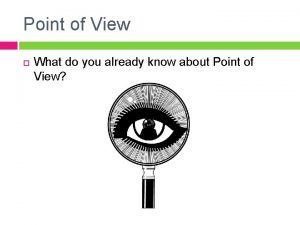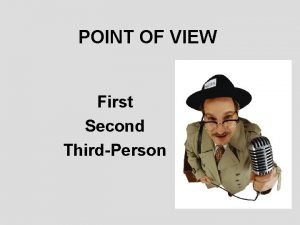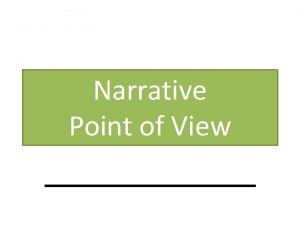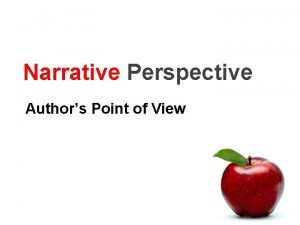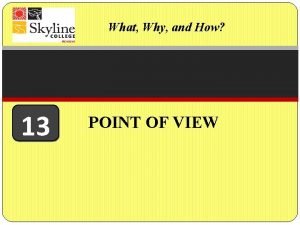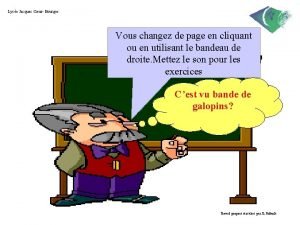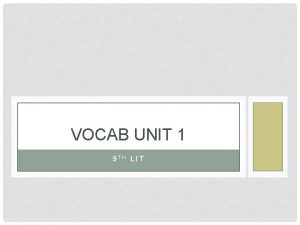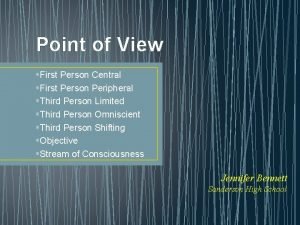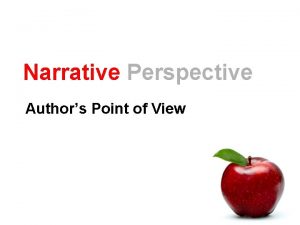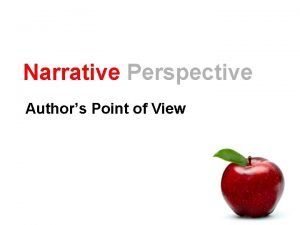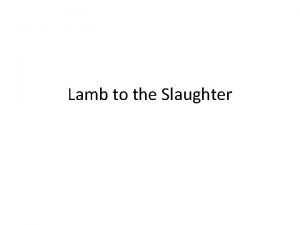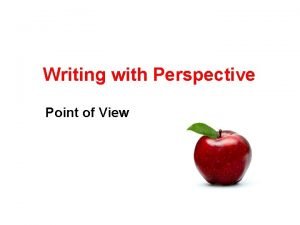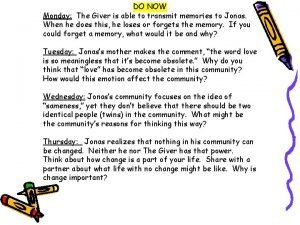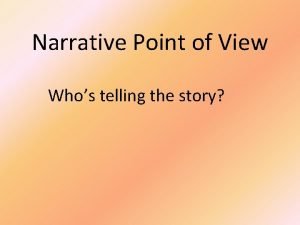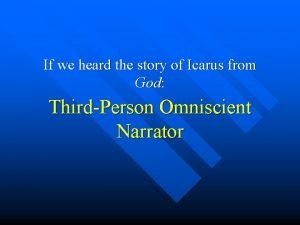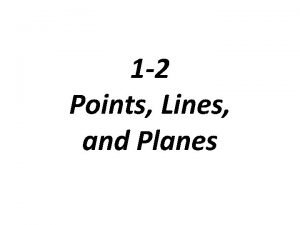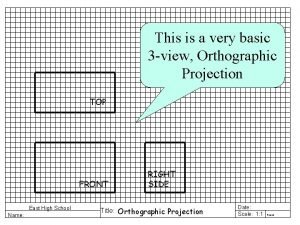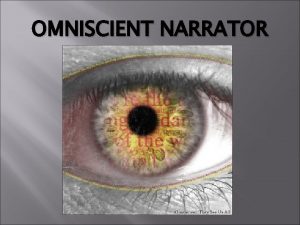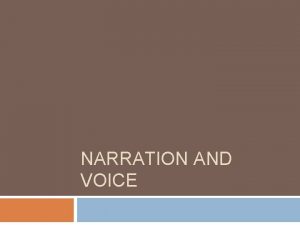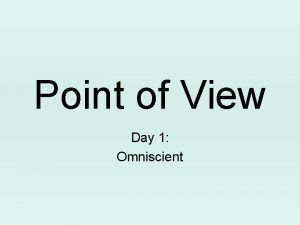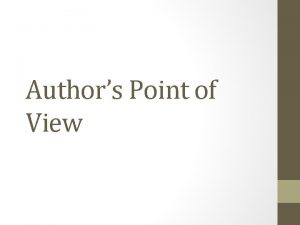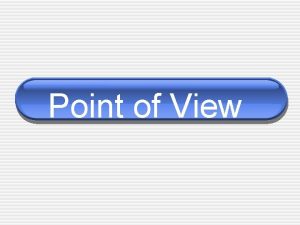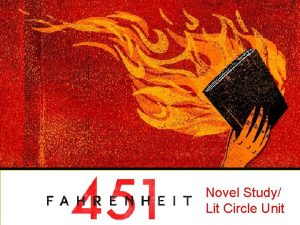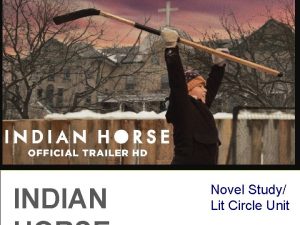Point of view Unit 4 Lit terms Omniscient
































- Slides: 32

Point of view Unit 4

Lit terms Omniscient Foreshadowing Epistolary Irony Allusion Vernacular Diction

Point of view The point of view is the vantage point from which the author presents a story. To determine the point of view, answer the following questions: Who speaks? To whom? In what form? At what distance from the action? With what limitations?

Who speaks?

First Person – The character tells the story, using the pronoun ‘I’. The only true “narrator”: I am telling my story As soon as I got to Borstal they made me a longdistance cross-country runner. I suppose they thought I was just the build for it because I was long and skinny for my age (and still am) and in any case I didn’t mind it much, to tell you the truth, because running had always been made much of in our family, especially running away from the police Alan Sillitoe, “The Lonliness of the Long-Distance Runner

Unreliable narrator “The truth is not distorted here, but rather a certain distortion is used to get at the truth. ” Flannery O’Connor In most stories we can (and should) trust the narrator to be telling us the truth. In others, however, we should not take the view of the narrator at face value. This is called an unreliable narrator. A narrator can be unreliable for a variety of reasons. Scout in To Kill a Mockingbird because she doesn’t know the whole story Holden in Catcher in the Rye because he wants to craft a specific view of himself for the reader

Second person Uses “you” Common for instruction books/manuals, text-based computer games (you are standing in a forest. Exits are N, S, E, and W), and choose-your-own-adventure games, but exceedingly uncommon in narrative fiction Can also use implied you First, try to be something, anything else. A movie star/astronaut. A movie star/missionary. A movie star/kindergarten teacher. President of the World. Fail miserably. It is best if you fail at an early age – say, fourteen. Early, critical disillusionment is necessary so that at fifteen you can write long haiku sentences about thwarted desire. It is a pond, a cherry blossom, a wind brushing against sparrow wing leaving for mountain. Count the syllables. Show it to your mom. Lorrie Moore, “How to Become a Writer”

Third person Uses “he”, “she”, “they”, etc. Omniscient – a POV with total knowledge and tells the reader directly what he is supposed to think. Objectively report what is happening Go into the mind of any character Interpret a character’s appearance, speech, actions, and thoughts Move freely in time or space Provide general reflections, judgments, or truth Limited omniscient – typically all the same benefits of omniscient, but with access to only one character’s mind Objective – an impersonal POV that only reports what can be seen/heard.

To whom? The reader Another character an epistolary is a story consisting entirely of letters written from one character to another or between characters The self Interior monologue Stream of consciousness

In what form? Narratives take many forms, which are typically interrelated to the point of view. What POV would each of the following use? Story Confessional Oratory Letter Journal Diary Interior monologue Stream of consciousness

Activity 4 -1 “Orientation” by Daniel Orozco

Exercises Set #1 Complete two of the five activities and add them to your writer’s notebook.

At what distance? Authorial distance is the degree to which we as readers feel intimacy and identification with or detachment and alienation from the characters in a story. It started in the backyards. At first the men concentrated on heat and smoke, and on dangerous thrusts with long forks. Their wives gave them aprons in railroad stripes to spur them on. Then it began to get mixed up who should do the dishes, and you can’t fall back on paper plates forever. Margaret Atwood, “Simmering” She dreams she does not already have three children. A squeeze around the flowers in her hands chokes off three and four and five years of breath. Instantly she is ashamed and frightened in her superstition. She looks for the first time at the preacher, forces humility into her eyes, as if she believes he is, in fact, a man of God. She can imagine God, a small black boy, timidly pulling the preacher’s coattail. Alice Walker, “Roselily”

Temporal distance “A long time ago in a galaxy far, far away” “Once upon a time” Stories narrated in the past promise that events will come to a conclusion because they already have. That spring, when I had a great deal of potential and no money at all, I took a job as a janitor. That was when I was still very young and spent money very freely, and when, almost every night, I drifted off to sleep lulled by sweet anticipation of that time when my potential would suddenly be realized and there would be capsule biographies of my life on the dust jackets of many books. James Alan Mc. Pherson, “Gold Coast”

Spatial distance Where is the “camera” – at the back of the room, on the character’s shoulder, etc. ? The closer the camera, the greater the emotional intensity and immediacy.

Spatial distance An unassuming young man was traveling, in midsummer, from his native city of Hamburg, to Davos-Platz in the Canton of Grisons, on a three weeks’ visit. From Hamburg to Davos is a long journey – too long, indeed, for so brief a stay. It crosses all sorts of country; goes up hill and down dale, descends from the plateau of Southern Germany to the shore of Lake Constance, over its bounding waves and on across marshes once thought to be bottomless. Thomas Mann, The Magic Mountain Her face was half an inch from my face. The curtain flapped at the open window and her pupils pulsed with the coming and going of the light. I know Jill’s eyes; I’ve painted them. They’re violent and taciturn, a ring of gas-blue points like cold explosion to the outside boundary of the iris, the whole held back with its brilliant lens. A detonation under glass. Janet Burroway, Raw Silk





“Ironic” http: //www. youtube. com/watch? v=Jne 9 t 8 s. Hp. Uc http: //blogs. publishersweekly. com/blogs/shelftalker/? p=3933 (lyrics) http: //www. collegehumor. com/video/5806921/actually-ironic (video) https: //www. youtube. com/watch? v=6 GVJp. Oma. Dy. U (James Cordon)



irony In a broad sense, irony is the recognition of the difference between expectations and reality Dramatic irony – when the reader/audience knows more than the characters do Verbal irony – when the actual intent is expressed in words that carry the opposite meaning (sarcasm) Situational irony – a situation in which actions have an effect that is opposite from what was intended (there must be a reasonable expectation, though)

allusion An allusion is a reference to another story, work of art, historical figure, event, or other external source. The most common allusion in English literature are to the Bible and mythology.

vernacular Vernacular is the local language of common speech or (as an adjective) stories written in such a local language. The term distinguishes living languages from dead languages (e. g. French or English rather than Latin or Greek); the use of a colloquial rather than a formal style.

diction Diction refers to the writer's distinctive vocabulary choices and style of expression in a story. This sometimes applies to use of formal or correct language, but broadly refers only to the author’s word choice. Read “How I Met My Wife” and discuss the unique diction http: //mentalfloss. com/article/49720/12 -lonely- negative-words

Activity 4 -2 “Jealous Husband Returns in Form of Parrot” by Robert Olen Butler

Exercises set #2 Choose at least two of the six exercises to complete. Put this in your writer’s notebook.

Unit assignment Time travel piece

Sorry, Right Number By Stephen King For further examples check out: “An Occurrence at Owl Creek Bridge” “A Sound of Thunder” The Time Traveler's Wife X-Men: Days of Future Past

 Third person omniscient
Third person omniscient Third-person omniscient
Third-person omniscient Point of view in a story
Point of view in a story Third person limited point of view examples
Third person limited point of view examples What is point of view in a story
What is point of view in a story Point de vue omniscient
Point de vue omniscient Ap lit literary terms
Ap lit literary terms Ap lit poetry terms
Ap lit poetry terms Falling action definition
Falling action definition Like terms and unlike terms in polynomials
Like terms and unlike terms in polynomials Combining like terms definition
Combining like terms definition Unit 7 ap lit mcq
Unit 7 ap lit mcq Ap lit vocab unit 1
Ap lit vocab unit 1 Third person omniscient
Third person omniscient Third person point of view example
Third person point of view example Third person point of view
Third person point of view Omniscient 3rd person
Omniscient 3rd person 3rd person omniscient
3rd person omniscient John slaughter
John slaughter Model-based reflex agents examples
Model-based reflex agents examples Omniscient agent
Omniscient agent Third person omniscient clue words
Third person omniscient clue words Is the giver third person omniscient
Is the giver third person omniscient Omniscient narrator
Omniscient narrator Icarus third person
Icarus third person Regional terms anterior view
Regional terms anterior view Unit 6 review questions
Unit 6 review questions Undefined terms
Undefined terms The orthographic view directly above the front view
The orthographic view directly above the front view Revolved view
Revolved view Revolved section meaning
Revolved section meaning Full sectional drawing
Full sectional drawing Worms eye view examples
Worms eye view examples
